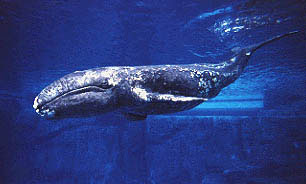
Eschrichtiidae or the gray whales is a family of baleen whale with a single extant species, the gray whale, as well as four described fossil genera: Archaeschrichtius (Miocene), Glaucobalaena and Eschrichtioides (Pliocene) from Italy, and Gricetoides from the Pliocene of North Carolina. Some phylogenetic studies have found this family to be invalid, with its members nesting inside of the clade Balaenopteridae. The names of the extant genus and the family honours Danish zoologist Daniel Eschricht.
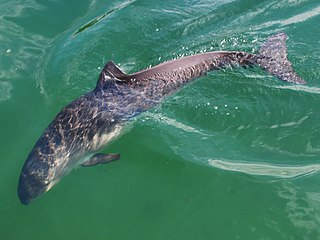
Porpoises are small dolphin-like cetaceans classified under the family Phocoenidae. Although similar in appearance to dolphins, they are more closely related to narwhals and belugas than to the true dolphins. There are eight extant species of porpoise, all among the smallest of the toothed whales. Porpoises are distinguished from dolphins by their flattened, spade-shaped teeth distinct from the conical teeth of dolphins, and lack of a pronounced beak, although some dolphins also lack a pronounced beak. Porpoises, and other cetaceans, belong to the clade Cetartiodactyla with even-toed ungulates.
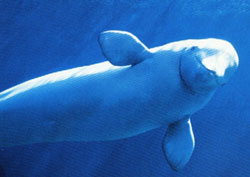
The cetacean family Monodontidae comprises two living whale species, the narwhal and the beluga whale and at least four extinct species, known from the fossil record. Beluga and Narwhal are native to coastal regions and pack ice around the Arctic Ocean. Both species are relatively small whales, 3–5 m (9.8–16.4 ft) in length, with a forehead melon, and a short or absent snout. Premaxillary teeth are absent. They do not have a true dorsal fin, but do have a narrow ridge running along the back, which is much more pronounced in the narwhal. They are highly vocal animals, communicating with a wide range of sounds. Like other whales, they also use echolocation to navigate. Belugas can be found in the far north of the Atlantic and Pacific Oceans; the distribution of narwhals is restricted to the Arctic and Atlantic Oceans.

Mesoplodont whales are 16 species of toothed whale in the genus Mesoplodon, making it the largest genus in the cetacean order. Two species were described as recently as 1991 and 2002, and marine biologists predict the discovery of more species in the future. A new species was described in 2021. They are the most poorly known group of large mammals. The generic name "mesoplodon" comes from the Greek meso- (middle) - hopla (arms) - odon (teeth), and may be translated as 'armed with a tooth in the centre of the jaw'.

Balaenoptera is a genus of rorquals containing eight extant species. Balaenoptera comprises all but two of the extant species in its family ; the genus is currently polyphyletic, with the two aforementioned species being phylogenetically nested within it.

The rough-toothed dolphin is a species of dolphin that can be found in deep warm and tropical waters around the world.
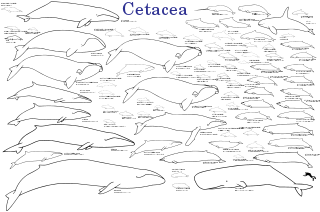
The evolution of cetaceans is thought to have begun in the Indian subcontinent from even-toed ungulates (Artiodactyla) 50 million years ago (mya) and to have proceeded over a period of at least 15 million years. Cetaceans are fully aquatic mammals belonging to the order Artiodactyla and branched off from other artiodactyls around 50 mya. Cetaceans are thought to have evolved during the Eocene, the second epoch of the present-extending Cenozoic Era. Molecular and morphological analyses suggest Cetacea share a relatively recent closest common ancestor with hippopotami and that they are sister groups. Being mammals, they surface to breathe air; they have five finger bones (even-toed) in their fins; they nurse their young; and, despite their fully aquatic life style, they retain many skeletal features from their terrestrial ancestors. Research conducted in the late 1970s in Pakistan revealed several stages in the transition of cetaceans from land to sea.
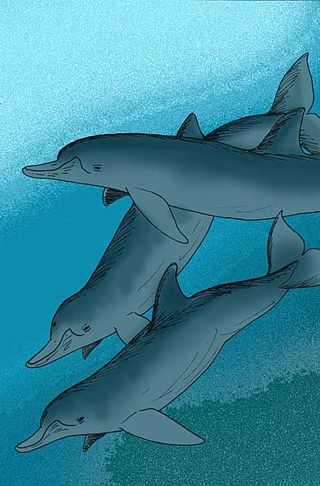
Australodelphis mirus is an extinct Pliocene dolphin. A. mirus is known from fossils found in the Sørsdal Formation, Mule Peninsula, Vestfold Hills, East Antarctica. The genus has been described as an example of convergent evolution with beaked whales.

Delphinoidea is the largest group of toothed whales, including 66 genera in 6 families. The largest living member of the superfamily is the killer whale, which can reach 6 tons, while the smallest is the vaquita.
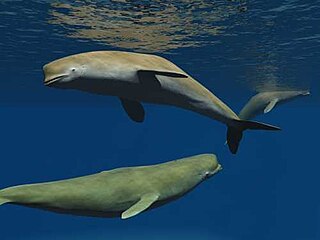
Bohaskaia is an extinct genus of beluga-like odontocete cetacean known from the Early Pliocene of Virginia and North Carolina, United States. It was first named by Jorge Vélez-Juarbe and Nicholas D. Pyenson in 2012 and the type species is Bohaskaia monodontoides.
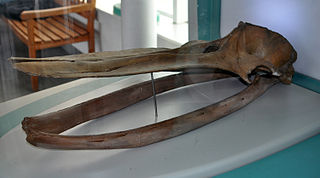
Piscobalaena is an extinct genus of cetaceans, which lived from the Middle to Late Miocene epochs in Peru and Florida. Its fossils have been found in the Pisco Formation of Peru and the Bone Valley Formation of Florida. At least some individuals of this diminutive whale were preyed on by the shark O. megalodon.
Nannocetus is an extinct baleen whale belonging to the family Cetotheriidae.
Auroracetus, from Aurora and the Latin cetus (whale), is a genus of Pontoporiidae, the river dolphins, and contains one extinct species. The species Auroracetus bakerae was published in 2009.

Albicetus is a genus of stem-sperm whales that lived during the Miocene Epoch, around 15 million years ago, and was discovered in Santa Barbara, California in 1909. It was categorized for decades as belonging to a group of extinct walruses erroneously thought to be sperm whales. It was named Albicetus, meaning "white whale", is a reference to the leviathan in Herman Melville's classic 1851 novel Moby-Dick.
Aprixokogia is an extinct genus of cetacean in the family Kogiidae that lived during the Pliocene in what is now North Carolina. It shared its habitat with ancestors of the modern pilot whale and pygmy right whale, as well as sea turtles and Pelagornis.
Balaenoptera bertae is an extinct species of baleen whale that lived from 3.35 to 2.5 Mya during the Pliocene in the region of today's San Francisco Bay Area. Il held, also during the early to middle Neogene, a diverse assembly of cetaceans. Their fossilized remains were found in the Purisima Formation. The species Balaenoptera bertae was discovered in 2013.
Hoplocetus is an extinct genus of raptorial cetacean of the sperm whale superfamily, Physeteroidea. Its remains have been found in the Miocene of Belgium, France, Germany and Malta, the Pliocene of Belgium and France, and the Pleistocene of the United Kingdom and South Carolina.
Casatia is a genus of extinct cetacean from the Early Pliocene, approximately between 5.1 and 4.5 million years ago. The genus contains a single species, C. thermophila. It was described from a partial skull. Its closest relatives are the narwhal and beluga, yet the remains were found farther south than its relatives, supporting the theory that monodontids evolved from warm water genera before becoming adapted to cold water.
Osodobenus is an extinct genus of walrus from the Miocene to Pliocene of California. Osodobenus may have been the first tusked walrus and shows several adaptations that suggest it was a suction feeder, possibly even a benthic feeder like modern species. Three skulls are known showing pronounced sexual dimorphism, with the female lacking the same tusks as the male. Only a single species, Osodobenus eodon, is currently recognized.











